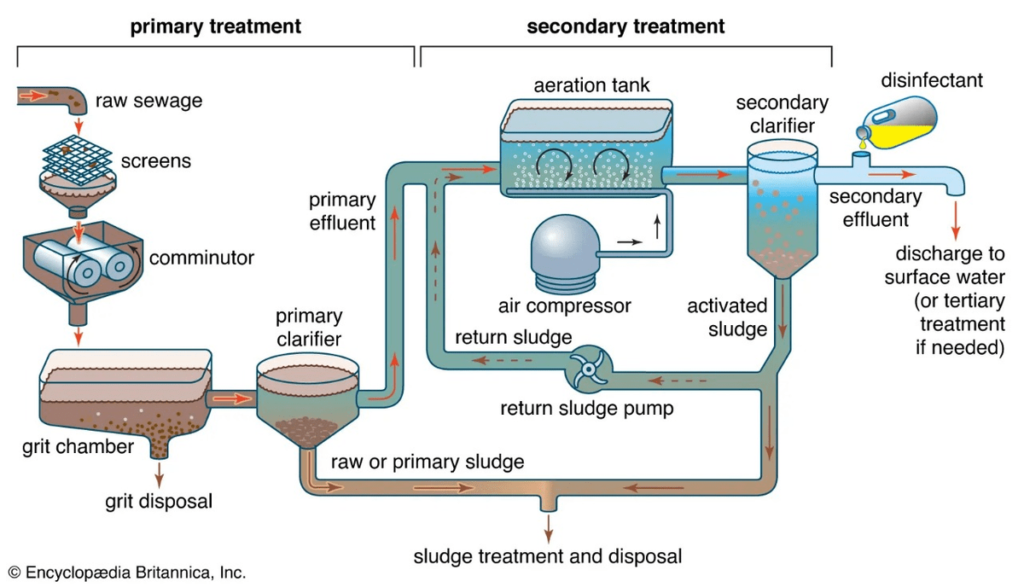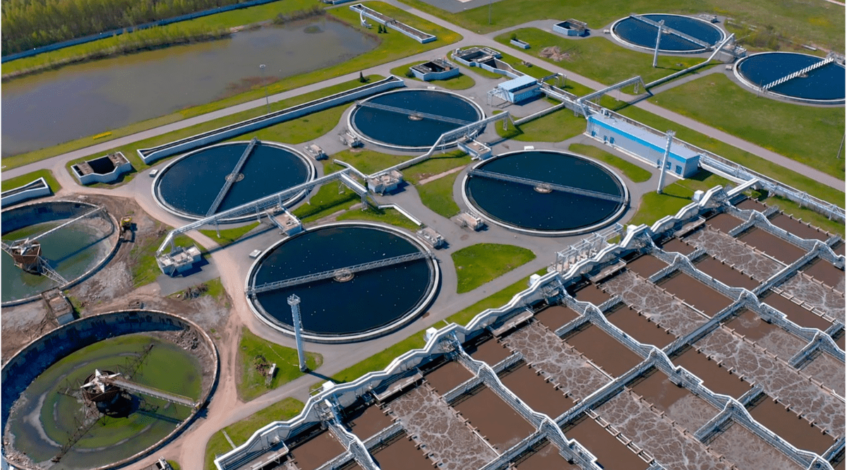Sewage treatment is a type of wastewater treatment which aims to remove contaminants from sewage to produce an effluent that is suitable for discharge to the surrounding environment or an intended reuse application, thereby preventing water pollution from raw sewage discharge.
Purpose of sewage treatment plant
The overall aim of treating sewage is to produce an effluent that can be discharged to the environment while causing as little water pollution as possible, or to produce an effluent that can be reused in a useful manner. This is achieved by removing contaminants from the sewage. It is a form of waste management.
Some types of sewage treatment produce sewage sludge which can be treated before safe disposal or reuse. Under certain circumstances, the treated sewage sludge might be termed “biosoilds ” and can be used as a fertilizer.
Working of sewage treatment plant
Sewage treatment often involves two main stages, called primary and secondary treatment, while advanced treatment also incorporates a tertiary treatment stage with polishing processes
• Primary treatment
In this “removal of a portion of the suspended solids and organic matter from the sewage” It consists of allowing sewage to pass slowly through a basin where heavy solids can settle to the bottom while oil, grease and lighter solids float to the surface and are skimmed off. These basis are called “primary sedimentation tanks” and floating materials are removed and the remaining liquid may be discharged or subjected to secondary treatment. Primary settling tanks are usually equipped with mechanically driven scrapers that continually drive the collected sludge towards a hopper in the base of the tank where it is pumped to sludge treatment facilities.
Sewage treatment plants that are connected to a combined sewer system sometimes have a bypass arrangement after the primary treatment unit. This means that during very heavy rainfall events, the secondary and tertiary treatment systems can be bypassed to protect them from hydraulic overloading, and the mixture of sewage and storm-water receives primary treatment only.
Primary sedimentation tanks can be expected to remove 50-70% of the suspended solids and 25-40% of the biological oxygen demand (BOD)
• Secondary treatment
This is designed to remove as much of the solid material as possible. They use biological processes to digest and remove the remaining soluble material, especially the organic fraction. This can be done with either suspended-growth or biofilm processes. The microorganisms that feed on the organic matter present in the sewage grow and multiply, constituting the biological solids, or biomass. These grow and group together in the form of flocs or biofilms and, in some specific processes, as granules. In several treatment processes, the biological floc or biofilm and remaining fine solids can then be settled as a sludge, leaving a liquid substantially free of solids, and with a greatly reduced concentration of pollutants.
reduce organic matter (measured as biological oxygen demand) from sewage, using aerobic or anaerobic processes. The organisms involved in these processes are sensitive to the presence of toxic materials, although these are not expected to be present at high concentrations in typical municipal sewage.
Design aspects
• Population equivalent
• Process selection
• Odor control
• Energy requirements
• Co-treatment of industrial effluent
• Design aspects of secondary treatment processes
• Non-severed areas
Environmental impacts
Sewage treatment plants can have significant effects on the biotic status of receiving waters and can cause some water pollution, especially if the treatment process used is only basic. For example, for sewage treatment plants without nutrient removal.
water pollution the contamination of water bodies usually as a result of human activities, in such a manner that negatively affects its legitimate uses. Water pollution reduces the ability of the body of water to provide the ecosystem that it would otherwise provide.. Water pollution results when contaminants are introduced into these water bodies. Water pollution can usually be attributed to one of four sources: sewage, industry, agriculture, and urban runoff including storm water. For example, releasing inadequately treated wastewater into natural waters can lead to degradation of these aquatic ecosystem. Water pollution can also lead to water-borne diseases for people using polluted water for drinking, bathing, washing or irrigation Supplying clean drinking water is an important ecosystem service provided by some freshwater systems, but approximately 785 million people in the world do not have access to clean drinking water because of pollution.
How can Hyper Help with this!?
Hyper Filteration deals in all kinds of waste water treatment plants including Zero Liquid Discharge Plant( ZLD).We also deal in Sewage Treatment Plants(STP) Effluent Treatment Plant(ETP), RO Plant, with technology like Membrane bioreactor (MBR).We also provide customized solutions for Mineral Water Plant. For the most reliable system in the wastewater, call Hyper filteration.. Contact Us to day for your queries and our solutions.


